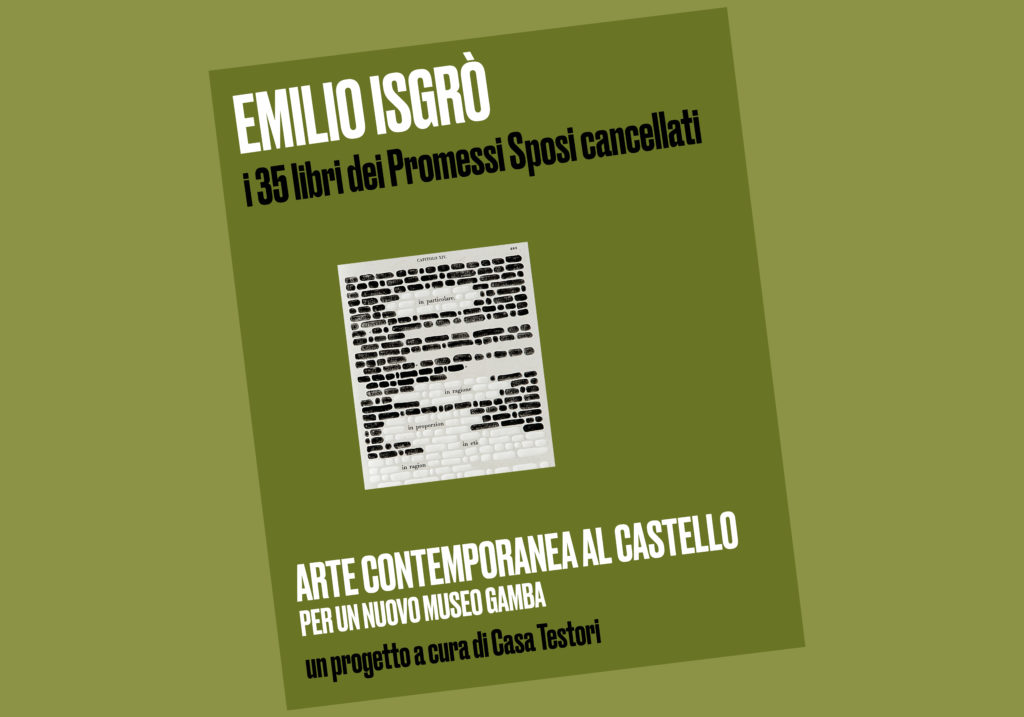EMILIO ISGRÒ. I 35 LIBRI DEI PROMESSI SPOSI CANCELLATI
Emilio Isgrò
Curated by Davide Dall’Ombra
Castello Gamba – Museo d’arte moderna e contemporanea
Châtillon, Valle d’Aosta
6 April – 16 June 2019

EMILIO ISGRÒ. THE 35 BOOKS OF THE BETROTHED, DELETED
Davide Dall’Ombra
«In deleting the work, I came to realise how Manzoni’s writing being so powerful and pure has contributed to our literature second only to Dante. Since in Manzoni, culture too becomes nature».
At the centre of the exhibition Emilio Isgrò’s most impressive work is exhibited: the 35 deleted books dedicated to the most famous pages of The Betrothed by Alessandro Manzoni.
I Promessi Sposi cancellati per venticinque lettori e dieci appestati is a work from 2016, specifically created for display at Casa Manzoni, in Milan.
It is shown here, not just for its magnificent beauty and because it is illustrative of the poetics of the artist and his renowned deletions, but because it is a useful tool for understanding the creative effect that the intuition of the centrality of the word had on the artist.
This is well expressed in the work of Isgrò housed in Castello Gamba and accessible on a tour of the Museum.
The work is compiled of 35 copies of the novel, opened at symbolic pages, and exhibited in individual plexiglass display cases. The volumes used are an anastatic reprint of the novel’s first edition in its final version (Quarantana); the edition that Manzoni had Alessandro Goin illustrate, under precise instructions. Isgrò, Sicilian artist relocated to Milan, worked on the 70 pages in his usual fashion: he deleted almost all of the text with black ink or white paint, allowing key words to survive, either untouched or permitted to emerge because of the transparency of the marks he made. It is these untouched words that create a new text or better, provide us with a synthetic and poetic key to interpretation of the chosen passage. What might seem offensive reveals itself in fact to be an act of love. Isgrò’s actions throw us into the heart of the text helping us to understand the greatness of Manzoni’s writing.
This is how, when silence is needed, nothing can be said, or newly added, only commas remain, marking the passage of time and to reassure us that something that cannot be described by words is happening. More often than not a few words are left untouched to evoke an entire chapter, like the conversion of the Unnamed: “dio, lo, Dio”. At times the strokes are more pictorial, visible when the two souls of the Nun of Monza appear, simultaneously in black and white.
As regards the other sections, the pictorial beauty of the recreated pages is not lacking and is an essential component of the harmony transmitted by the work. The deletions provide a musical rhythm to the pages and the alternation of black and white is poetic in itself. But it is most certainly the words of Manzoni, trimmed down and smoothen like small, precious rocks that glisten amongst the grooves created by the artist, restoring the text with a greater evocative power. Three simple “ands”, surviving in the emptiness of the page, prolonging the anticipation of a happy ending implicit in the novel, whilst entirely new sentences, like that born of Fra Cristoforo’s instructions, “direte barca rispondete amore” dissolve the lines between writing and figurative art. The greatness of this work lies in this synaesthesia between these two languages.
A novel in general and, as Giovanni Testori underlines, Manzoni in particular, directs the reader, word after word, to the culmination of a feeling, an emotion, rage or pity whichever it arouses, falling in with the rhythm of language and its narration. A work of art, on the other hand, plays out immediately, before the viewer: it is as if we were able to read the entire novel in an instant, said Testori. Writing and figurative art have very different times for fruition: one can make us run or walk, whilst the other obliges us to take an immediate Olympic dive. Here then, with his deletions, Isgrò impresses on literature the breakneck speed of art allowing us to embrace the essence of an entire chapter in the blink of an eye.
Yet, at the same time with a work like this, we are brought, book after book, a stream of characters or photograms, at a pace typical of reading, formed by understanding, appreciation, wonder and profound self-identification.
THE EXHIBITION
A new exhibition for a new Casa Testori project, desired and supported by the Autonomous Region of Valle d’Aosta. This project has seen Casa Testori conduct a study of the collection of the Castello GambaMuseum, the museum that houses the Valle d’Aosta’s 20th century collection, identifying a number of works and masters capable of acting as a pivot for future enhancement initiatives, so that the Gamba Castle can definitively earn its rightful place as an essential destination for tourists to the castles in the Valle d’Aosta and a favourite haunt of the region’s inhabitants.
The first result of this collaboration is the exhibition Emilio Isgrò. I 35 libri dei Promessi Sposi cancellati(The 35 Cancelled Books of the Betrothed), which displays an important and articulated work by one of the most important Italian conceptual artists, in dialogue with his painting conserved at Castello Gamba: Quel che è scritto (1991), presented for the occasion with new effective interpretations. This is the fifth “episode” of the successful exhibition series Détails, with which Castello Gamba enhances the value of its heritage, drawing the public’s attention to one of the authors present in the collection.
Download the exhibition guide here











